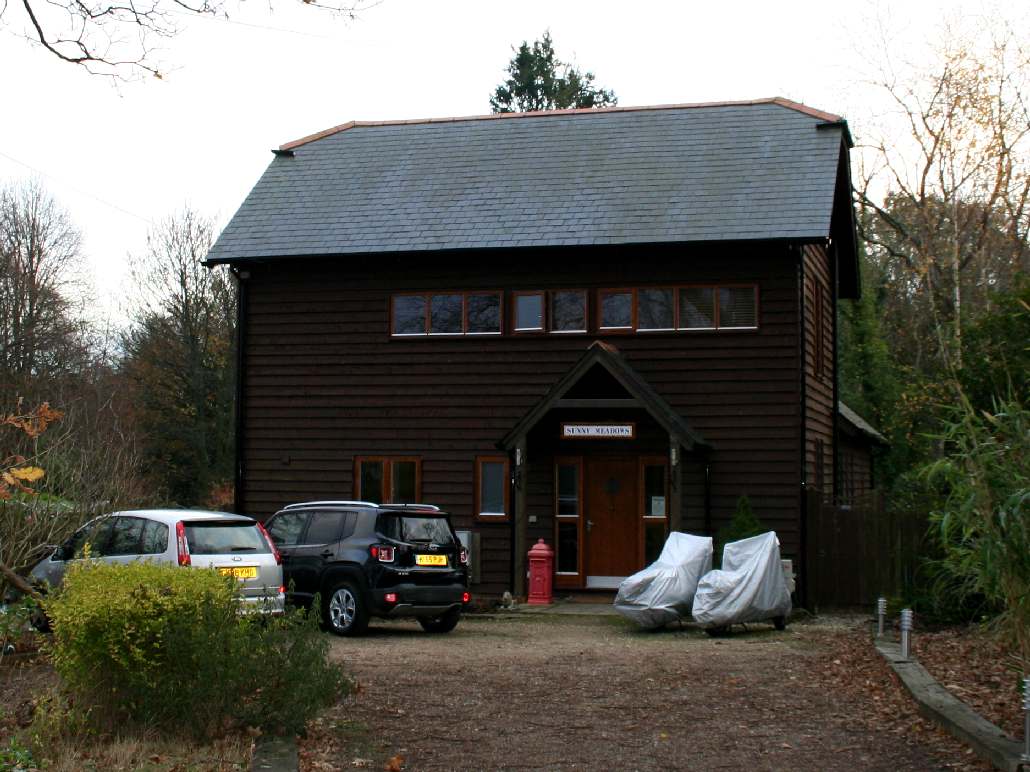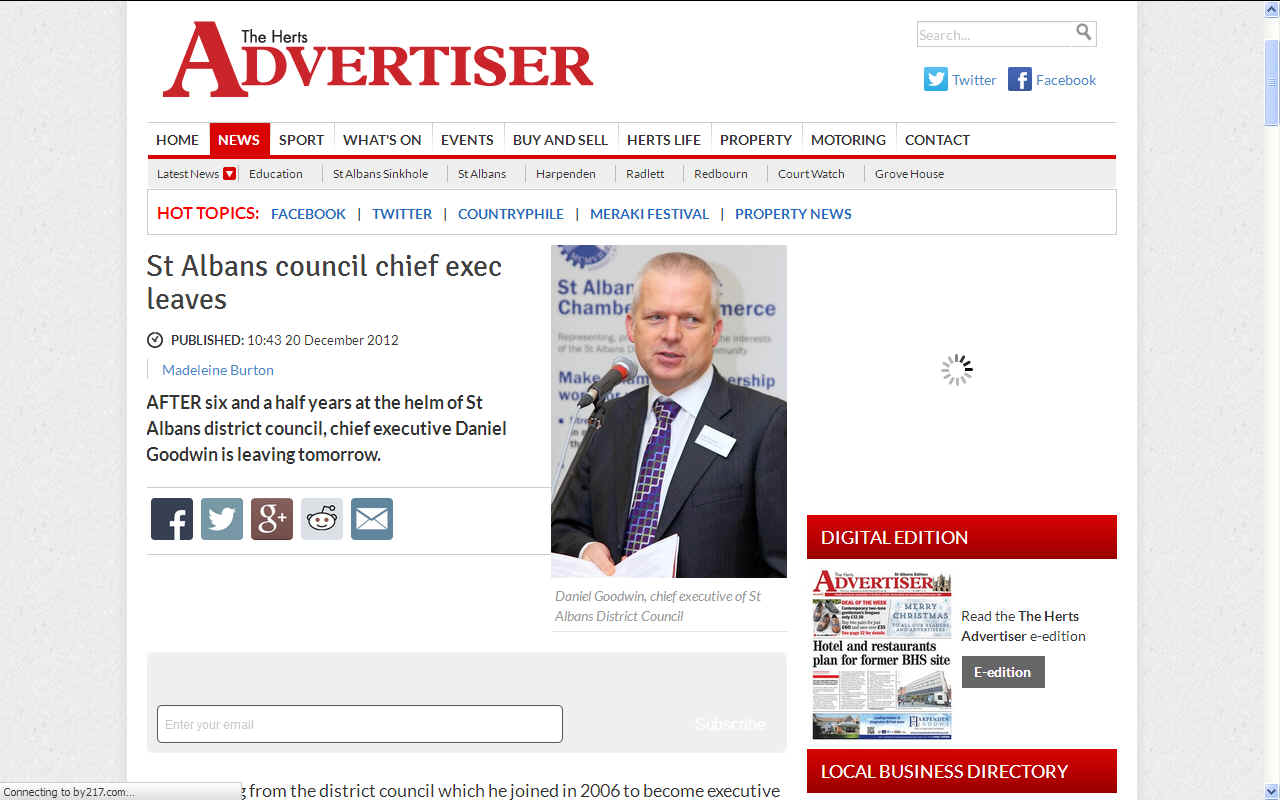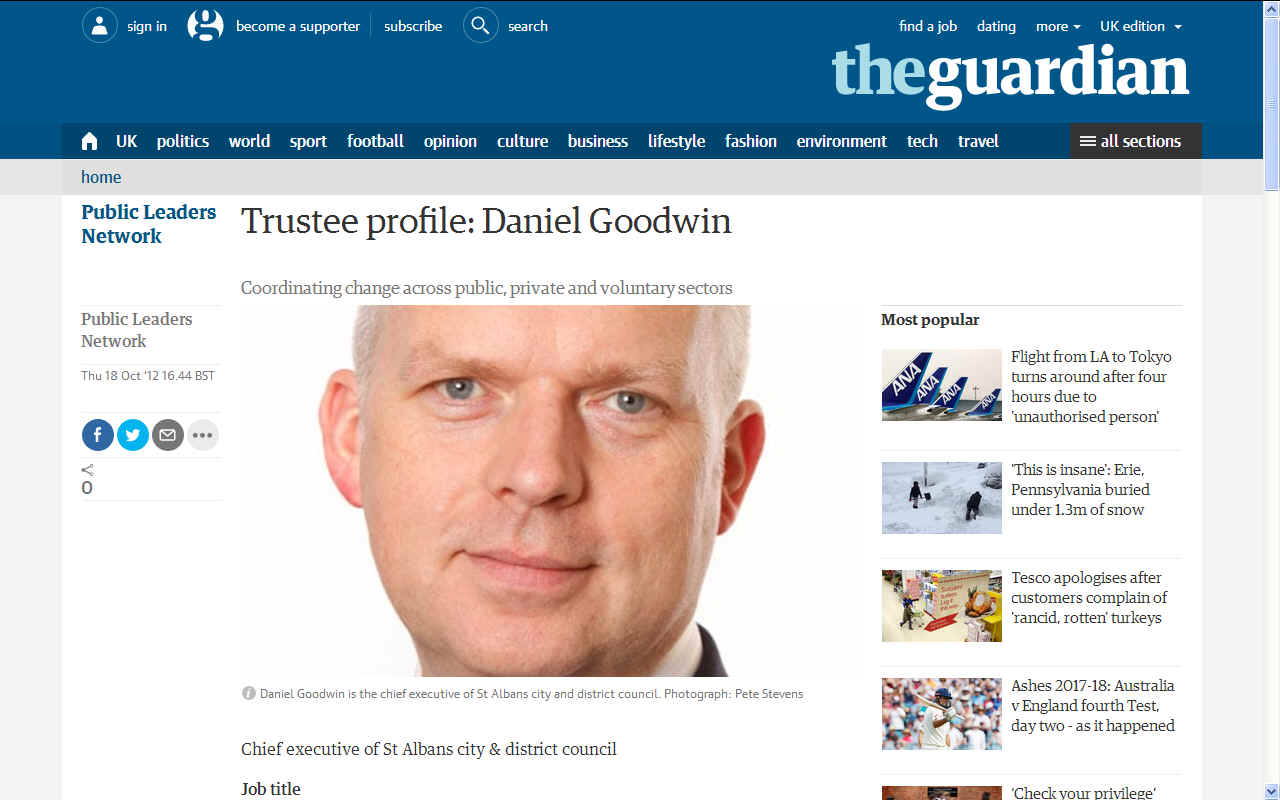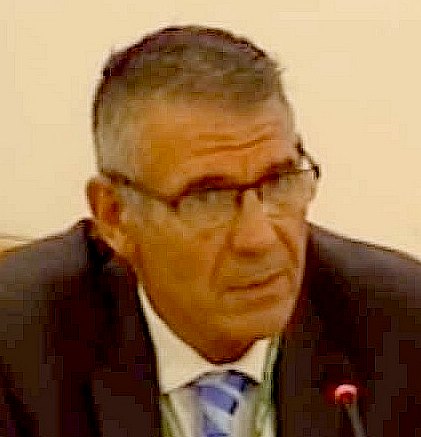|
Daniel
Goodwin was the Chief Executive of Wealden
District Council in 2003 when this council negotiated a Consent
Order in the Eastbourne County Court with Trevor
Scott and Andrew Long
present during meetings and presumably, party to the negotiations.
Other
Wealden chief executives, it appears, had abandoned their positions as
chief executive following the Petition
scandal where the Sussex Police had
supplied Wealden's officers with a blank sheet of paper to write what
they wanted read out in respect of the 12 allegations of misconduct in
public office. It is alleged that this involved Derek Holness, Sheelagh
Douglas and Lesley Barakchizadeh, or at least that these chief
executives had held CE positions prior to Mr Goodwin taking the reigns.
Wealden
had issued a Statutory Demand in respect of the toilet
appeal to the High Court before Dame
Elizabeth Butler-Sloss who had ordered costs for Wealden of around
£26,455.95. Victorio Patrick Scarpa
issued and signed the SD dated the 15th of October 2003.
It
is alleged that this was a fraudulent demand based on an Order that the
High Court were not empowered to make and that Wealden duped Lady
Justice Steele into breaching the Health
& Safety Regulations 1992 and of course Articles
8 and 14.
The
victim of this conspiracy to pervert the course of justice was Nelson
Kruschandl, the subject of a long-running vendetta that began in 1982
and really got going when Inspector Raymond Dannruether allowed himself
to be deceived by George White and
Thomas Hoy during an appeal in
1986/7 when the Secretary of State was told that the old generating
buildings was a pump house build on the foundations of the generating
works. We now know from a Report in 1999 that this was not true and the
extant generating
buildings are original. But Wealden chose to ignore their foul deed
and pressed to try and cover up the maladministration. Mr Kruschandl's
response was to issue a counter claim as per this Affidavit:
IN THE EASTBOURNE COUNTY COURT No. 16 of 2003
4 The Avenue, Eastbourne, E. Sussex
BETWEEN:
WEALDEN DISTRICT COUNCIL
Claimant
And
NELSON JAMES KRUSCHANDL Respondent
AFFIDAVIT
I, Nelson James Kruschandl, of The Old Steam House, Lime Park, Herstmonceux in East Sussex, make this Affidavit in reply to the Statutory Demand served on me by
Wealden District Council (the claimant Council) on Wednesday the 3rd December 2003 and in support of my application to set it aside.
SUBJECT OF THE DEMAND
1. The costs the subject of the Claimant Council’s Statutory Demand arise from this Council’s long-term unwillingness to reasonably assist the Respondent to secure a recognised beneficial use for the historic building, he occupies as his home, against which it is their function and duty to protect the historic built environment. The refusal to so assist the Respondent is therefore perverse.
2. Whereas, it has been clearly established in the case between Associated Provincial Picture Houses Ltd v Wednesbury Corporation 1948 that the Claimant, being a local authority, owes the Respondent a duty to act reasonably and not irrationally, and must not make a decision or initiate an action or sustain a refusal to act that is perverse, and especially not so where such actions or decisions are to the disadvantage of, or prejudicial to the Respondent or exhibit bias.
3. Where the Respondent has applied to the Claimant, on a number of occasions, for planning permission to attain recognition for his use of The Old Steam House, the Claimant has been unhelpful and deliberately obstructed the Respondent’s application(s) contrary to the principle established in
Davis v Wansdyke District Council 2001 (Bristol County Court).
PRACTICE DIRECTION IN INSOLVENCY PROCEEDINGS
4. The Court may set aside a Statutory Demand as seen at Section B1-012 headed Miscellaneous Practice Directions, copy of which is appended to this Affidavit as an exhibit.
5. Accordingly, this present application to set aside is made under S. 12 (4): Where the debtor a) claims to have a counterclaim, set off or cross demand (whether or not he could have raised it in the action in which the judgement or order was obtained) which equals or exceeds the amount of the debt or debts specified in the Statutory Demand or b) disputes the debt (not being a debt subject to a judgement or order) the Court will normally set aside the statutory demand if, in its opinion, on the evidence there is a genuine triable issue.
6. Irrespective of any potential claim requiring the Court to go behind the making of the Order, this application to set aside is made on ground a) against which the Respondent adduces the Sealed Writ and the Order of Master Eyre dated 16th December 2003 to accompany the Claim Form and having heard the Respondent in person, confirming leave to issue.
7. The Courts attention is drawn to the claim for damages in excess of £50,000. Consequently, the Respondents Claims against the Claimant in set off or counterclaim significantly exceed the value of the Claimant’s Statutory Demand.
HIGH COURT ORDER
8. Responding to the Claimant’s Statutory Demand, the Respondent at first applied for Legal Aid via a solicitor in Hastings, no local solicitor offering an appointment within 10 days or at all.
9. Six days into the 18 days allowed to challenge the Claimants Statutory Demand, on the 9th December, the Hastings solicitor advised Legal Aid was not available for such matters, leaving just 12 days to file in the County Court.
10. The Respondent then went directly to the County Court to ascertain the, or any procedure to set aside the Claimant’s Demand in respect of a counterclaim or other cause of action against which the Respondent had placed the Claimant on Notice in 2000 via a solicitors letter and 2001 in person by recorded delivery.
11. In his efforts to clarify his counterclaim, the Respondent attended the Royal Courts of Justice – Citizens Advice Bureau on Monday 15th December, having been unable to contact the RCJ CAB via the telephone, which was continuously engaged between the hours advertised.
12. During a short interview with volunteer solicitors, the Respondent was advised he could set aside the Demand because he had a valid cause of action in damages and to lodge a Claim on Form N1 then develop his argument in the intervening 14 days allowed to serve his Particulars of Claim.
13. The Respondent attended the Royal Courts of Justice again on Tuesday 16th December. Having satisfied the Court as to eligibility for Remission against the £980 issue fee, the Respondent sought leave to lodge his Claim in a format suitable to cover his claims, to be particularised in due course.
14. The Respondent attended before Master Eyre, who granted leave, also imposing strict conditions as to clarification, which clarification will indeed take some time to achieve due to the complexity of Human Rights legislation and the other issues raised.
15. Despite the Respondent’s best efforts, this is not achievable in the time available to prepare this Affidavit seeking to set aside the Claimant’s Demand so as to comply with the time limits to lodge an application in the County Court (on 19th December 2003). There being a weekend cutting off two days, so reducing the 18 days to apply to16 days effectively.
16. However, the points raised herein, although not in final form and being incomplete, nevertheless contain sufficient substance to form the basis for a hearing, hence there is a genuinely triable issue.
17. The Respondent served the Members of the Claimant in person, to include the Claimant’s Monitoring Officer, on the morning of the 17th December 2003. This event was witnessed and photographed by a member of the public, should service be disputed.
18. The Claimant’s Chief Executive refused service in person, however, the Claimant at large and other officers were served at the Claimants offices and receipts obtained for each service, which receipts are appended to this Affidavit as exhibits.
THE CLAIMANT’S MONITORING OFFICER
19. Sometimes it is the case that not doing something is as damaging to a person as doing something. Such as in failing to shore up or underpin a subsiding building, will eventually see its ruination.
20. Whereas, the Claimant is charged with certain duties and obligations to adhere to procedure as laid down by statute and other Government guidelines, and especially so where the Courts have said local authorities should pay heed to such guidelines.
21. Accordingly, the Claimant’s Monitoring Officer is required to make report to the full council in any matter involving or likely to sustain an injustice as seen in the Local Government and Housing Act 1989 (C42) at S. 5 subsection 2 It shall be the duty of a relevant authority’s monitoring officer, if it at any time appears to him that any proposal, decision or omission by the authority, by any committee or officer of the authority or of any joint committee on which the authority are represented constitutes, has given rise to or is likely to or would give rise to -
(a) a contravention by the authority, by any committee, sub-committee or officer of the authority or by any such joint committee of any enactment or rule of law or of any code of practice made or approved by or under any enactment; or
(b) any such maladministration or injustice as is mentioned in Part III of the [1974 c. 7.] Local Government Act 1974 (Local Commissioners).
22. Unfortunately, in this case the Claimant’s Monitoring Officer is also the Claimant’s solicitor and legal services manager, having conduct of this matter since at least 1986.
23. The fact the Monitoring Officer is important in this matter, is that the Monitoring Officer sitting in his role as legal adviser to the Planning Committee, has introduced the identity of the applicant, being the Respondent, as a material consideration. As an officer of the Court a solicitor is under a duty to present a
balanced report to a committee not containing irrelevant information likely to cause misdirection, a committee being a quasi court.
24. Whereas, the identity of a person applying for planning permission is not to be introduced as a Material Consideration, after the findings of the Local Government Ombudsman in his Report investigating complaint numbers 94/B4989 and 95/B/2327 against Castle Point Borough Council.
25. Equally, the issue of bias or apparent bias has been ruled to invalidate any decision reached by a planning committee, as per R. v Bassetlaw ex parte Oxby (Dec 1997) wherein the High Court declared as illegal and void a grant of planning consent tainted by actual or apparent bias.
26. Conversely, it must be that a planning refusal or indeed an enforcement report tainted by actual or apparent bias should be declared illegal or void, where the general principle applies to any decision reached by a committee of a local authority.
27. Thus, the Monitoring Officer, in failing to make report as required by the Local Government Act, as to the apparent bias he personally introduced, not only is the Claimant in breach of a statutory requirement, but the Claimant through their Monitoring Officer’s refusal to fulfil his statutory function, are also knowingly perpetuating a situation where the Respondent may not enjoy the use of his home peacefully contrary to the Human Rights Act, Article 8, after the decision of the Secretary of State in Duffy v
New Forest District Council 2001.
28. Equally, as in the above decision involving the New Forest District Council, the matter of bankruptcy or causing the family concerned to face possible bankruptcy was considered by the Secretary of State to be an unlawful interference in the Duffy family home.
DECLARATIONS
29. Additionally, where the planning committee sitting to determine the Respondent’s application number WD/98/0996/F were directed by their legal advisor as follows: “there would be considerable incentive for this applicant to carry on as he is at the moment, put the planning permission in his back pocket and perhaps pass it on when he eventually sells it to somebody else….” He directed the committee to consider matters not pertinent to the application, and a transcript of the meeting is available.
30. Whereas, it has been established in the case of R v Canterbury City Council ex parte Springimage Ltd (JPL 1993). Wherein it was established that any decision by a planning committee based on incorrect information or direction as to the law is void. In application 0996 above, the Claimant’s solicitor misdirected the Members to ignore fresh evidence as to the history of The Old Steam House, which evidence is a material consideration.
31. When considering the Claimant’s duty to be reasonable and whether they acted reasonably in this case, the Respondent cites R. v Teeside Development Corporation ex parte William Morris Superstore PLC & Redcar & Cleveland Borough Council (JPL P.23 1998). This case set the precedent where balanced reports should be presented to committee, rather than bits of advocacy to support one point of view.
32. In a later case citing the Redcar & Cleveland Borough Council case, R. v Selby District Council ex parte Samuel Smith Old Brewery (CO/2561/99) the precedent was extended so that a failure to consider other material planning considerations constituted an imbalance. Whereby council officers must give the members of the Council a balanced view with supporting information.
33. Consequently, in light of the Claimant’s present action seeking to bankrupt the Respondent, and the Claimant refusing to act on the Respondent’s reasonable request that the Claimant’s Monitoring Officer should compile a Report as to the perceived maladministration, that and other misinformed decisions constituting an omission, and leading to and perpetuating injustice, the Respondent is entitled to seek declarations as to the validity or otherwise of the Claimant’s extant decision(s) refusing the Respondent planning permission for his home.
34. In respect of the declarations sought in the action now begun in the High Court under Claim number HQ03X03821 issued with the leave of the Court to serve the Claim Form and with the Particulars of Claim to follow before 30th January 2004, the Respondent if successful in his Claim(s) will be entitled to significant damages equal to or exceeding the Claimant’s money claims.
BRIEF HISTORY
35. It may assist the Court to look firstly at a brief history of the relationship between the Claimant and the Respondent over the 20 year period beginning in 1982.
36. Between 1982 and 1983 the Claimant issued a Tree Preservation Order on dangerous and diseased Sycamore trees encircling The Old Steam House. The objective being to hamper the Respondent’s conservation works.
37. Between 1984 and1985 the Claimant enforced against the Respondent seeking to prevent a commercial use of the historic building in question.
38. Between 1986 and 1997 the Claimant enforced against the Respondent again seeking to prevent a residential use of the historic building.
39. During the period 1982 to late 1997 the Respondent did not have in his possession proof as to the historic value of The Old Steam House building, however, the Claimant pursued High Court injunctions
demanding the removal of toilet and washing facilities and subsequently seeking committal.
40. At no time have the Claimant offered any genuine assistance to the Respondent as to a reasonable beneficial use for the historic building.
41. Between May 1998 to March 2000 the Respondent applied for planning consents citing proof as to the historic value of The Old Steam House, which met with serious obstruction in the form of failure to advise and recommendation to the Respondent to apply for a commercial use.
42. Between March and September 2000 the then Leader of the Council, Rupert Thornely-Taylor suggested the owner (not the Respondent) of the building should apply for permission to erect a replacement building.
43. Between March 2000 and October 2000 the Respondent pursued the commercial use the Chairman of the Planning Committee
(Councillor
Hubbard) had invited, until the Economic Development Manager refused to assist the Respondent further as seen in his letter dated 4th October 2000.
44. Some time later the Respondent realised the planning officers had planted a seed in the members mind, in the full knowledge they had argued a commercial use in this location would not be appropriate, even photographing their vehicles to prove two cars could not pass in the drive.
45. Since October 2000, the Respondent, realising he would be unable to achieve a fair hearing until the Claimant’s earlier maladministration was rectified, he has lobbied the members and formally requested a Report as to the perceived injustice from the Claimant’s Monitoring Officer as seen in the Respondent’s letter dated 1st December 2001. This is the correct procedure as far as the Respondent is aware.
46. On 10th October 2001, it came to the Respondent’s attention that the Claimant were able to and did indeed abandon Orders it had made, where these orders were based on incorrect information.
47. Evidence of this is produced in the Report compiled by Graham Kean concerning a footpath under reference number JT2320.0101b.
48. It is therefore accepted practice by the Claimant, that where they have made an order based on incorrect information, it is abandoned. Consequently, the Claimant could have put the matter right by another route, but chose not to.
INCOMPATIBILITY
49. In the case of County Properties v Scottish Ministers (July 2000) it was determined that the Scottish planning system provided no right of appeal to an independent tribunal established in law, where the right of appeal to the High Court was limited, in that case requiring assessment at to the historic value of a building, the Court ruled it did not have the necessary jurisdiction to review the substantive issues of the case.
50. Concerning the finding of Lord Mac Fadyen in the Scottish case, it may be the Court would wish to consider issuing a Declaration of Incompatibility. This may come about where the building the Respondent occupies as his home is of some historic value, which the Claimant denies. Accordingly, English planning law as defined by the Town and Country Planning Act 1990 as amended, fails to satisfy the requirement of Article 6 of the Human Rights Act, intended to secure for everyone the right to a fair hearing.
51. The Monitoring Officer has refused to compile such Report in denial of his statutory function, but continued to threaten the Respondent repeatedly as to bankruptcy.
52. Consequently, as these officers have dug in their heels to protect mistakes they might easily have admitted in 1987 or 1988, they have worked ever harder to conceal the historic truth and the value either English Heritage or the County Archaeologist may have accorded the building, in so doing nursing a lie.
53. In the case of Slough Developments v Welwyn Hatfield Garden City Council, significant damages were awarded to the developer, where it was established officers of that council had kept information of their ownership of property from the developer. In so doing in the words of the Court, “nursing a lie”.
54. From about 1993, the officers efforts to cover earlier impropriety were accelerated such that they more obviously neglected procedural compliance, taking advantage of the Respondents procedural ignorance as a layperson.
55. After discovery of proof as to the correct history and procedure beginning in 1997, it became clear this Council had an alternative agenda directed at the Respondent personally, where resistance as to the actual use of the building has subsided in favour of seeking financial ruination.
56. The Respondent believes this tactic has been adopted by the Claimant, because they fear invoking human rights issues from where the Respondent might qualify for legal aid, hence be in a better position to obtain expert planning advice and representation.
57. The Respondent is aware that some Members of this Council are opposed to the officer’s conduct which they finally recognise as a malicious course of conduct, some of which Members are speaking out against.
58. If the objective of this Council had been to recover monies, then they were asked by the Respondent to proceed to recovery in 2000, but failed to act. Correspondence from the Chief Executive to members suggests this Council were prepared to wait to let other persons having a financial claim against the Respondent, have a go at taking the Respondent’s home, to go first as it were.
59. However, such co-operation with a recently appointed Trustee in review, seeking possession of the historic building, raises questions as to the motivation of the Council, where clearly if the Trustee had succeeded, they would then obtain nothing themselves financially.
60. No sooner the Trustee reviewing the Respondent’s case (after 9 years) abandoned his claim, than immediately this Council took over the running. The objective being to part the Respondent from his occupation of the historic building, so removing his standing in the matter. The Claimant hopes to achieve this by bankrupting the Respondent for a second time, then appointing a pet Trustee to obtain possession via the back door.
WEBSITE PUBLICATIONS
61. What has further driven the Council to action is the fact the Respondent continues to assist other victims generally via a website by distributing planning caselaw and featuring cases where this council have been found guilty of maladministration by the Ombudsman or the Courts.
62. The Council have taken legal advice as to removal of the website. This is confirmed in a front page newspaper feature in the
Sussex Express dated 14th February 2003.
63. The right to freedom of expression and to receive and impart information, is protected via Human rights legislation. The Respondent believes this fact has caused the Claimant to finally pursue him to bankruptcy as threatened since about 1995.
64. In particular, the Respondent assisted and represented a local horse sanctuary at appeal after the Claimant had
demolished their stables. Having personally suffered attacks by this Council the Respondent knew how they operated and used this knowledge to good effect, to obtain a favourable decision at appeal.
65. The officer having the running of the enforcement matters, the Respondent is concerned with is David Phillips.
Mr Phillips has already admitted misleading the Claimant’s planning committee in the Eastbourne County Court. This officer is also responsible for taking action where he was advised by the Claimant’s solicitor, Mr Scrapa, the Council had no legal standing. However, this did not dissuade Mr Phillips and later the
Ombudsman found against the Council in that matter.
66. It would seem to the Respondent most likely that Mr Phillips is now heading the unfavourable actions directed at his person. There is a web page about Mr Phillips, that is one of the most frequently visited, concerning the operation he lead to demolish the above mentioned horse sanctuary. Mr Phillips has not responded to the page, despite being invited to do so.
LEADER OF THE COUNCIL
67. The Respondent recently spoke with the Leader of the Council, Councillor
Nigel Coltman, again raising these issues, having laid out his concerns in writing some time ago.
68. The newly elected Leader, replied by letter dated 14th August 2001. In this letter Councillor Coltman confirms he has read: “all the arguments you present, and agree that my new role as Executive member with responsibility for Finance, brings me concern about the cost of your application to the Wealden ratepayers.”
69. As far as the Respondent is aware, Councillor Coltman has taken no direct action designed to prevent the officers continuing with their malicious course of conduct. If he has done so, he did not mention that to the Respondent when they spoke earlier this month.
70. Nor did Councillor Coltman indicate he would or intended to place controls on his officers on which the Respondent could rely, but suggested yet another planning application, which the Respondent takes as an admission to the facts.




DISCRIMINATION
- It is unlawful to discriminate against any person or organisation, with
reference to Article 14
of the Human
Rights Act 1998.
That said, preferential treatment appears to be routinely given to some
members of the community, while Wealden DC use their position of trust to
give others a very rough ride to foster the finances of those they may
have helped in the past for some kind of consideration.
The
pictures above are some examples of planning consents (or development
agreed as permitted) that has been granted in and around Lime Park,
Herstmonceux. In the case of Lime View and Oak View [lower right], this is a
massive semi-detached house built on green belt without any suggestion of affordability
or other special circumstances. Double garages is a luxury not a
necessity. Compare the cooperation of Wealden in the procurement of these
consents, with the £500,000 spent to prevent the restorations of Herstmonceux
Museum. Anyone looking at the facts would have to question why this
council is acting so perversely - when planning permission all around the
site is being given for much larger developments. To include a grant for 70
houses in the adjacent field. You might ask if the builders were
connected in any way with any council member - and if they were if
suitable declarations were made.
Wealden's
declarations record is the only record in the country that we have seen
with tipp-exed entries and backdating. With one particularly notable entry
for Ian
Kay, when he was caught out by a member speaking about his
father-in-law's application in Pevensey Bay. On this occasion George White
was sitting next to Ian Kay, have written on the file that Kay should have
no involvement with B. Best's application. White was on course in on it
with Kay. After Kay had left the room disgraced, George Morham White
carried on where Kay had left off, as if nothing had happened. This sort
of thing happens all over the country in District and Parish councils and
it has got to stop.

CHURCH
ROAD HERSTMONCEUX - What a lovely house. But, and this is a big but,
where are the sustainable energy
features? Another missed opportunity
and we wonder what the incentive was to allow this development to
proceed. As we said, Wealden are talking the talk, but not walking the
talk. This is a house in Church Road that was still being built in
December 2017.
INCONSISTENCY
71. The Claimant is under an obligation to apply its policies consistently and fairly. In similar circumstances and location, one might therefore expect the Claimant to refuse residential permission on redundant buildings in the countryside and adjacent residential property.
72. However, there is demonstrable inconsistency, where an old farm milking shed some 800 yards distant, being of no particular historic or architectural interest, listed or otherwise cited on a Monument Protection Programme, was granted permission for conversion to a single dwelling house. I refer to photographs of The Old Dairy.
73. Other similar applications for the retention of redundant farm buildings were not refused, or the applicant advised to apply for a commercial use, as being a reason for refusal, but in these cases where the applicant had not furnished a statement as to his efforts to market the property in question commercially, the other residential applications were simply deferred so as not to put the applicant(s) to additional trouble in having to re-apply.
74. The reason the Claimant put the Respondent to the additional trouble, was and is to keep the balls in the
air, to obstruct the Respondent and keep him going in circles. This is something about which the Respondent seeks declarations in the
High Court action begun 15th and issued 16th December 2003 under Case Number HQ03X03821.
MEMBERS DUTIES
75. In the case Wilson v First County Trust 2001 in the Court of Appeal, the first declaration of incompatibility between the Human Rights Acts 1998 and Consumer Credit Act was made, wherein the general principle was established that the provisions of the 1998 Act have an effect on cases involving private parties. In this case the private parties are Officers and Members of the Claimant Council, separately or collectively, should that become an issue.
76. Where the rights in question touch upon positive obligations and deal with cases involving common law, the Respondent relies on the obligation to develop common law to be compatible with Convention Rights (by virtue of s. 6(3).
77. In consideration of the Convention Rights and the Claimant’s “Members code of conduct”, the elected Members appear to be under an obligation not to discriminate unlawfully against any person, as seen at Part 1 General Obligations 2 (a).
78. It follows that this Council accept discrimination is unlawful, although the
United Kingdom has not written
Article 14 into domestic law, the UK is nevertheless a signatory to the
European Convention of Human Rights and should observe protocol and work toward a natural harmony.
FREEDOM OF SPEECH
79. The Council may not expend public money to protect the reputation of its members or of any officer. If an officer or member has a grievance against any member of the public, they may if they feel they have grounds, institute proceedings privately from their own pocket.
80. Regarding this present Statutory Demand, it appears planning officers are attempting to use public money to fund for their own purposes and to fight their own battles, with the backing of the Claimant’s directors and possibly Cabinet Members, using the pretence of debt recovery as authorisation.
81. In respect of the above and the claim of authorisation by the Council’s solicitor, it appears from the Council’s Constitution at 14 .3 under Legal Proceedings, that effectively the Council’s solicitor (also the Claimant’s Monitoring Officer) has authorised himself by virtue of: “……or in any case where the council’s solicitor considers that such action is necessary to protect the Council’s interests”. This requires some clarification.
82. It may be therefore that in this case Mr Scarpa has taken the initiative where the Respondent is assisting disadvantaged members of the public and the officers have taken a dislike to the Respondent for sharing his information via the web, against which, they could not otherwise lawfully prevent.
83. However, any move to restrict the rights of the Respondent regarding expression or the right to receive and impart information, may be in contravention of the rights accorded the Respondent under
Article 10 of the European Convention of Human Rights, without interference by public authority.
OFFICERS CODE OF CONDUCT – A COURSE OF MALICIOUS CONDUCT
84. In so far as the Respondent’s Claim in the High Court may be affected by time limits, the Respondent relies on the fact that the course of conduct complained of, may have begun some time ago, but that it is ongoing.
85. Had the Claimant acceded to the reasonable request of the Respondent to agree to mediation or indeed for their
Monitoring Officer to compile a Report as required under the Local Government Act, the injustice would then hopefully have been identified and subsided.
86. Equally, where it is the intention to bankrupt the Respondent, it must be the case that the Claimant continues to escalate their chosen course of conduct and in so doing confirm the Respondents Claims as concerning ongoing matters.
CONSERVATION ISSUES
87. As for the duty of the Claimant to the historic built environment, David Phillips is the Claimants National Parks representative and conservation officer.
88. Councillor Mrs Sylvia Tidy is thought to be a member of the South Downs Conservation Board.
89. Councillor Tidy was also Chairman of the former Strategic Planning and Economic Development committee known as SPED. In this position she had responsibility for planning issues and could have used her authority to order review of the Respondent’s case.
90. At the same time as her Chairmanship with SPED Councillor Tidy sat on the Planning Committee. She spoke in favour of the Respondent exploring the commercial application
Councillor Hubbard was fronting to obstruct the Respondents
1999 planning
application.
91. The former District Planning Officer, Ashley Brown, is an amateur archaeologist.
92. The Respondent’s former Local Member, Councillor
Jarman, was an amateur archaeologist.
93. In this matter it may be necessary to examine the relationships between officers and members to identify cosy relationships that may hold sway such as to impair the said officers’ and members’ duty to render impartial decisions. This will best be achieved by oral examination of the Defendants under oath.
COMMON LAW OFFENCES
94. Regarding local authority employees, the common law offence of misconduct in public office applies generally to every person who is appointed to discharge a public duty and who receives compensation in whatever form; salary, expenses and the like. This principle was clearly established in the case of R. v Bowden 1995 Court of Appeal (98 1 WLR).
95. It has been established in law that a law enforcement officer, witness to an assault has a duty to preserve the peace and protect the victim. A failure to do so is seen as wilful neglect. This decision was upheld in the case of R. v Dytham 1979 (467 3 WLR) Court of Appeal. This case established that omitting to take steps to protect the person, or to arrest his assailants or otherwise bring them to account, constitutes the crime of failing to carry out a duty of his office.
96. In law it is an offence to do anything, which the ordinary man in the street might regard as harassment. This is seen in the Protection from Harassment Act 1997 in Section 1 – A person must not pursue a course of conduct a) which amounts to harassment of another; and b) which he knows or ought to know amounts to harassment of the other. It is further stated in Section 2. – (1) A person who pursues a course of conduct in breach of section 1 is guilty of an offence.
97. Whereas, the members ought to have known: 1) that the repeated (181 recorded) visitations on the Respondent at his home and threats as to bankruptcy, and 2) that the abject refusal or failure to do anything to correct the perceived injustice, or 3) the failure to address or review the imbalanced reports, so as to perpetuate decisions appearing to be ultra vires, is tantamount to abandoning a victim of mental assault, hence a failure to carry out a duty of office.
98. That the criminal element of the above may not be within the jurisdiction of the Respondent’s Claim in the High Court, however it is arguable and this may be addressed via the interference with the Respondent’s peaceful enjoyment of his home. Additionally, a civil claim may be otherwise pursued.
DUTY TO THE HISTORIC BUILT ENVIRONMENT
99. It is the duty of the Claimant Council to protect the historic built environment. Where a historic building is unlisted and unscheduled, the Council should seek to protect the building via the planning process.
100. That this historic building should be protected via the planning process, is clearly stated in the Step 4 Report of a Monument Protection Programme, compiled by
English Heritage dated June 2000.
101. On receipt of a planning application, it is the Council’s duty to consult generally. On receipt of a planning application citing history as a reason to grant planning permission, it is the accepted procedure that the Council should consult English Heritage and the
County
Archaeologist. This procedure is clearly laid out in Planning Policy Guidance note 16.
102. The respondent has provided the Claimant Council every opportunity to grant planning permission and to negotiate for a planning permission, via applications in 1986, 1988, 1995, 1996, 1998 and 1999.
103. The handling of the Respondent’s 1998 planning application demonstrates the Council’s refusal to follow the correct consultation procedure to prevent any outside expert historic assessment from reaching the members, Inspectors or the Courts.
104. The 1999 planning application demonstrates that where the correct consultation procedure was initiated by the Respondent, the Claimant Council then further misdirected the members to refuse the application, having put it in the mind of the Chairman of the planning committee and other leading councillors, to ask the Respondent to pursue a commercial application.
105. The officers did this in the full knowledge they had already argued at a planning appeal, a deficiency in access for a commercial use at these premises.
106. The Council’s solicitor allegedly authorised to pursue the Statutory Demand, Victorio Scarpa, explained to the Respondent who was sitting in the gallery, that applying for lawful development certificate, was a “stage” to go through, prior to considering any planning proposal.
107. The costs could not have arisen if the Claimant Council had dealt with the Respondent’s various applications in a fair and balanced manner and after following the correct consultation procedures.
108. The unwillingness, obstruction and general unhelpfulness concerning the Respondent and his residential, or indeed any reasonable or beneficial occupation of The Old Steam House (OSH) building in Herstmonceux, occasioned by the Claimant Council amounts to obstruction.
109. The pursuit of sums accumulated a result of this Council’s long-term agenda to resist applications in the manner described in this document and in the full knowledge of the ongoing injustice against the Respondent, amounts to malicious course of conduct.
HEALTH AND SAFETY REGULATIONS
110. It appears that one set of costs relates to an Appeal to keep toilet facilities as required by
Health and Safety Regulations
1992. In this case the council acted unreasonably in seeking to deprive the Respondent of such facilities as provided by law, contrary to Wednesbury principles and the duty to act reasonably in dealings with the public. At the time of the hearing the Respondent did not have evidence to prove the history of the building.
111. It appears the other set of costs relate to a Lawful Development application where the Respondent had been asked by members to apply for a commercial use. This obviated any benefit from an appeal, but where the Council refused to agree to a withdrawal of an appeal lodged with the Planning Inspectorate. At this time the Respondent had new evidence of the history of the building, which the Council were doing their utmost to stifle.
112. In relation to these matters and the conduct of this Council the Respondent is pursuing a claim against the Claimant of which he placed them on Notice on 8th January 2000 by recorded delivery and subsequently re-stated these claims when the Claimant Council applied to the High Court for a Charging order between September and November 2002.
113. Unfortunately, on that occasion last year the Respondent was unable to pursue the matter when the Claimant withdrew immediately and on realisation the Respondent intended to apply for Legal Assistance to further his claim.
INTENTION TO BANKRUPT
114. The Claimant has aided and abetted and encouraged third parties to seek possession of the Respondent’s home.
115. The Claimant has itself sought to take possession of the Respondents home as per the Application for an Interim Charging Order dated 11 September 2002.
116. The Claimant has made it clear to persons on separate occasions that it is their intention to bankrupt the Respondent to resolve the planning situation to their satisfaction, should they fail to remove him from his home by other means. The Respondent intends to call these persons as witnesses to the fact.
117. Whereas, the intention to bring about such possession for such purpose is contrary to the Human Rights Acts 1998, the intention being to interfere with the Respondent’s
peaceful enjoyment of his home.
118. Since November 2002 the Respondent has written to the Council offering mediation in the hope this matter might be resolved without the need to litigate. The immediate response to his letter to the Council’s Chief Executive dated 21st July 2003 (and copied to their Executive Cabinet) was for their ex District Planning Officer, Ashley Brown, to reply on the Council’s behalf by email refusing the offer, thereby short circuiting the usual channels of communication.
119. In addition to the reasoning given above, a secondary objective of certain officers of the Council in pursuing the Respondent to bankruptcy, appears to be to prevent the respondent pursuing claims against them in respect of the above described prejudicial and unfavourable treatment about which there is ample evidence in support and about which there is brief reference to below without burdening the Court to detail, unless the Court so directs.
120. The Respondent relies on independently made recordings as transcripts, and other information overheard in the course of pursuing planning applications lodged with the Claimant Council. This information is supported by witness statements for the most part, but where no statement is available, witnesses are available to give oral evidence in support.
121. In particular and during the course of planning applications made between 1998 and 1999 the solicitor, Victorio Scarpa (VC), allegedly authorised by this Council to make this demand was overheard speaking with my Local member, Councillor Jarman (CJ) and
Councillor West (CW), after a planning meeting where the Council had declined to determine an application I had made, bringing proof to the table of the building’s historic origins.
122. During the exchange between VC, CJ and CW, Councillor West mentioned to the other two that he was aware of the history of the building, to which Mr Scarpa said something along the lines that the matter would only finally be resolved when the Council had bankrupt Kruschandl to take possession of the building or put him in
prison. This statement by Mr Scarpa was echoed by Councillor Jarman, who is unfortunately now deceased. However, I call Councillor West to give evidence of this exchange.
123. In fact this Council did seek an Order for Committal on one occasion, but on that occasion the Council’s officers had put
photographs in evidence they should not have had in their possession (having claimed to have returned them) also attributing an incorrect date to this evidence seeking to prove something that had not occurred, had occurred.
124. In similar circumstances to that described herein, a Judge in the Bristol County Court ruled that planning officers had: "conducted themselves in a consistently unhelpful and obstructive fashion" leading to a settlement in favour of Mr
Kelly Davis in an amount of £790,000 (Nov 2001).
125. Where the Claimant has produced reports to committee designed to gain authorisation to enforce, the officers have failed to mention to members the historic origins of the OSH building or suggested that this historic building held no viable use, contrary to expert opinion.
126. According to the R v Canterbury City Council precedent of (1993) this kind of unbalanced or one-sided report invalidates any decision the Council may have reached if successfully challenged. Hence if this be the case then any enforcement based on an invalid decision is itself ultra vires, assuming it can be demonstrated that this is how a report was presented, and on which point the Respondent will elaborate later. Accordingly, Victorio Scarpa will be aware that any authorisation he claims to be possessed of to pursue this matter, is herein challenged as to its validity and purpose.
127. Since the Respondents first occupation of the OSH in February 1982 until August 2000, he had no idea the officers of this Council had not informed the members that a building of considerable local historic interest was devoid of a reasonable and beneficial stand alone use. However, the Respondent now holds evidence to show this Council had know since at least 1984 they were dealing with a historic building, as may be seen from the Statutory Declaration of Chester Hudson dated 14th August 2000.
128. Since 1986 the Claimant has hidden the truth about the OSH history and failed to properly consult with English Heritage or the County Archaeologist – as they are charged to perform. Consequently, the Council has argued consistently in three applications before the Secretary of State, that the OSH building was devoid of any historic interest, as seen in the various Inspectors decision letters now produced as evidence..
ENGLISH HERITAGE
129. Further evidence to demonstrate the denial of the history attaching is the report by this Council’s conservationist, Chezel Bird, where the lady states that in her opinion the building holds no historic interest and goes on to deny the electricity generating origins. This was in 1995-6. Chezel Bird formerly worked for English Heritage.
130. When the Respondent contacted English Heritage in 1999, they confirmed commissioning a Monument Protection Programme (MPP) in 1994 as a means to identify and protect the scarce buildings, witness to the dawn of the age of electricity.
131. When the Respondent brought this to the attention of the Planning Inspectorate, they confirmed in a letter dated 16 July 2002 it was not in their power to restore the position and that they had simply accepted the Council’s evidence in good faith. Presumably, unaware of the obstruction the Respondent was experiencing, the Inspectorate advised applying for planning permission yet again.
132. As mentioned elsewhere, it is unfortunate the planning system has not yet caught up with the Human Rights Act and limits appeals to a point of law only. Therefore, ultimately the planning system as it stands offers no truly independent remedy to the Respondent.
133. Additionally, the Respondent is not aware the Cabinet has in fact authorised Victorio Scarpa to pursue this matter, when it is his understanding that the Cabinet who ultimately control the Council had instructed the Legal Department not to seek to recover the sum the Council now claim, and on which subject the Respondent would ask the Court for an Order for Discovery.
134. Further, and in relation to the Council’s claim for costs, the Respondent is aware of a conversation between Councillor Ryde, formerly head of the Council’s Finance Committee, relating to an Opinion this Council had obtained in relation to recovery of costs. The Respondent’s recollection is that the content of this Opinion spelled out the difficulty obtaining such costs, where the Council had acted in such manner as to attract a claim against negligence or obstruction.
135. The Opinion is material evidence of this Council’s knowledge they are now acting unlawfully, where the manner of instructing is suspect and indeed demonstrates the mind-set of the Council as to the malice in their present course. A sum for this and other Opinions is shown in the Council’s accounts against which the Respondent would ask the Court for an Order for Discovery.
136. The Claimant had ample opportunity to pursue this matter when the Respondent asked their then Chief Executive, Sheilagh Douglas, to do so several years ago. The timing of the Claimant’s Demand comes after refusal to mediate and after the Respondent asked them to confirm statutory limitations relating to a stable they demolished unlawfully (now rebuilt), which timing is designed to maximise the disturbance to the Respondent’s life and interference to the occupation of his home.
137. It may be that the Claimant is statute barred from further recovery proceedings and indeed the Claimant is required to account for the extraordinary delay in pursuing these matters, if not for the purpose of escalating their demand to suit their stated intention to bankrupt the Respondent.
DAMAGES
138. Section 8(1) of the Human Rights Act 1998 authorises a Court which has found that an act or proposed act of a public authority is unlawful, to grant ‘such relief or remedy, or make such order, within its powers as it considers just and appropriate’.
139. Damages may be awarded against other matters raised herein independently of any such provision in the Human Rights Act 1998.
140. Consequently, and in consideration of the loss of peaceful enjoyment the Respondent has suffered and having regard to the circumstances herein described, so perpetuating a situation where the Respondent is unable to resume the said peaceful enjoyment he is entitled to, the Respondent respectfully seek the assistance of this honourable Court, in applying to set aside the Council’s Statutory Demand so to allow his Claim in the High Court number HQ03X03821 to be heard and so as not to prejudice the Respondent.
Signed ……………………………………….. this 19th day of December 2003.
Before me:
Solicitor, registrar, or commissioner for oaths

THE HERST ADVERTISER -
DECEMBER 20 2012
AFTER six and a half years at the helm of St Albans district council, chief executive Daniel Goodwin is leaving tomorrow.
He is moving from the district council which he joined in 2006 to become executive director for finance and policy at the
Local Government Association.
His role will be temporarily taken on by the current deputy chief executive for public services, James Blake, leaving the other deputy chief executive, Coim O’Callaghan, who is responsible for finance to concentrate on the council’s 2013/14 budget.
Mr Goodwin’s departure is the catalyst for an internal restructure which will combine the chief executive’s role with one of the two deputy chief executive roles.
It means that both Mr Blake and Mr O’Callaghan can apply for the chief executive vacancy.

THE GUARDIAN OCTOBER 25 2012
- Trustee profile: Daniel Goodwin
Coordinating change across public, private and voluntary sectors
Chief executive of St Albans city & district council
Job title: Chief executive, St Albans city & district council
Q. How long have you been a trustee of the Solace Foundation?
A. A year
Q. How does being a trustee feed into your day job?
A. It provides me with a wide range of perspectives on improvement from colleagues within the sector and elsewhere
Q. What is the biggest governance challenge?
A. Enabling local government to be a leading voice across all three sectors, public, voluntary and private, to achieve a vision for the local community.
This article is published by Guardian Professional. Join the Guardian Public Leaders Network free to receive regular emails on the issues at the top of the professional agenda.

FRAUD
& MALFEASANCE IN PUBLIC OFFICE
The
Fraud Act 2006 (c 35) is an Act of the Parliament of the United
Kingdom. It affects England
and Wales
and Northern Ireland.
It was given Royal Assent on 8 November 2006, and came into effect on 15
January 2007.
The
Fraud Act 2006 should be read in conjunction with the The Serious
Organised Crime and Police Act 2005 and the Proceeds
of Crime Act 2002, but most importantly the Local
Land Charges Act 1972 in conjunction with the appropriate
Regulations.



 
Kelvin
Williams, Victorio Scarpa, David Whibley, Julian Black,
Daniel Goodwin
   

Christine
Nuttall, David Phillips, Douglas
Moss, Ian Kay, Charles Lant
Abbott
Trevor - Alcock
Charmain - Ditto - Arnold
Chris (Christine) - Barakchizadeh
Lesley - Paul Barker - Black
Julian - Boakes Beverley
Brigginshaw
Marina - Brown
Ashley - Coffey
Patrick - Douglas
Sheelagh - Dowsett Timothy - Flemming
Mike - Forder Ralph - Garrett
Martyn
Goodwin Daniel
- Henham J - Holness
Derek - Hoy
Thomas - Johnson
Geoff - Kavanagh Geoff - Kay Ian - Kay
I. M.
- Barbara Kingsford
Lant Charles - Mercer
Richard - Mileman Niall - Moon
Craig - Moss Douglas, J. - Nuttall
Christine - Pettigrew Rex - Phillips
David - Scarpa
Victorio
Scott
Trevor - Kevin Stewart - Wakeford
M. - Whibley David - White,
George - Williams
Kelvin - Wilson Kenneth - White
Steve
Vicarage Lane, Hailsham,
East Sussex, BN27 2AX T: 01323 443322
Pine Grove, Crowborough, East Sussex, TN6 1DH T: 01892
653311
LINKS https://www.theguardian.com/public-leaders-network/2012/oct/18/trustee-profile-daniel-goodwin-stalbans http://www.hertsad.co.uk/news/st-albans-council-chief-exec-leaves-1-1748483
|

















